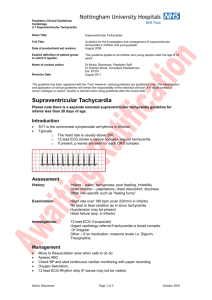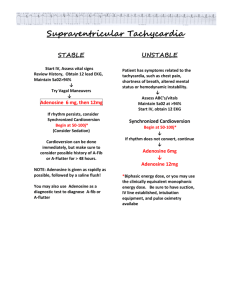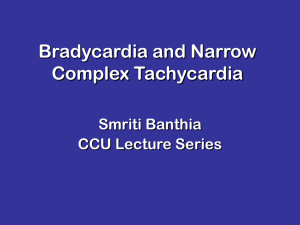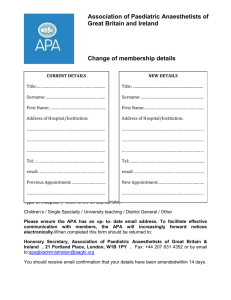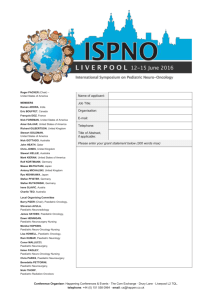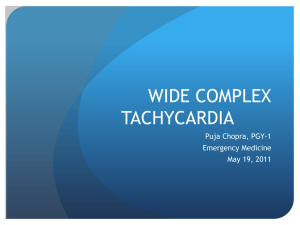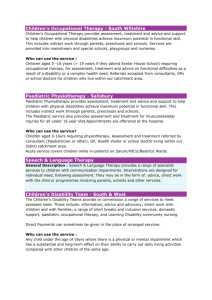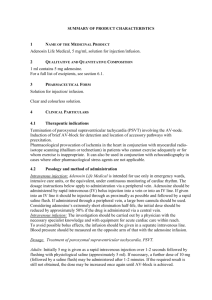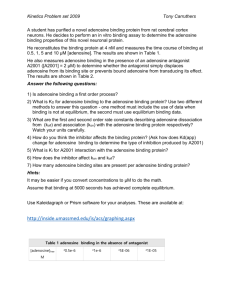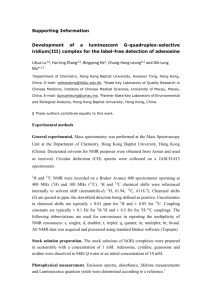SmPC agreed wording from Paediatric Worksharing for Adenosin
advertisement
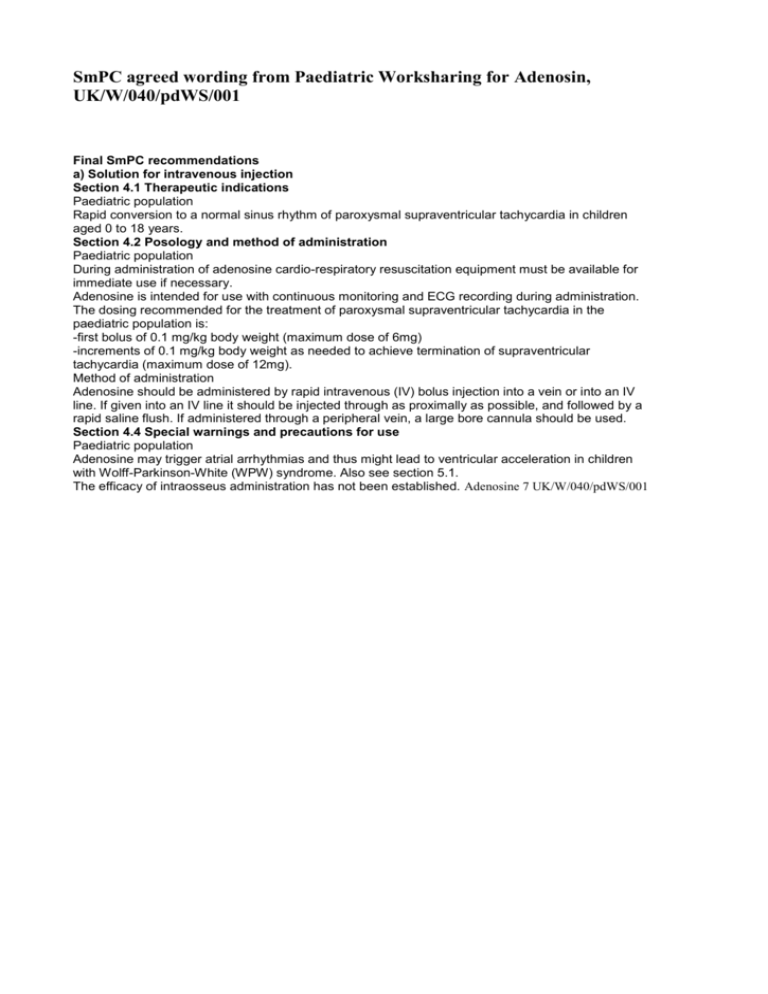
SmPC agreed wording from Paediatric Worksharing for Adenosin, UK/W/040/pdWS/001 Final SmPC recommendations a) Solution for intravenous injection Section 4.1 Therapeutic indications Paediatric population Rapid conversion to a normal sinus rhythm of paroxysmal supraventricular tachycardia in children aged 0 to 18 years. Section 4.2 Posology and method of administration Paediatric population During administration of adenosine cardio-respiratory resuscitation equipment must be available for immediate use if necessary. Adenosine is intended for use with continuous monitoring and ECG recording during administration. The dosing recommended for the treatment of paroxysmal supraventricular tachycardia in the paediatric population is: -first bolus of 0.1 mg/kg body weight (maximum dose of 6mg) -increments of 0.1 mg/kg body weight as needed to achieve termination of supraventricular tachycardia (maximum dose of 12mg). Method of administration Adenosine should be administered by rapid intravenous (IV) bolus injection into a vein or into an IV line. If given into an IV line it should be injected through as proximally as possible, and followed by a rapid saline flush. If administered through a peripheral vein, a large bore cannula should be used. Section 4.4 Special warnings and precautions for use Paediatric population Adenosine may trigger atrial arrhythmias and thus might lead to ventricular acceleration in children with Wolff-Parkinson-White (WPW) syndrome. Also see section 5.1. The efficacy of intraosseus administration has not been established. Adenosine 7 UK/W/040/pdWS/001 Section 5.1 Pharmacodynamic properties Paediatric population No controlled studies have been conducted in paediatric patients with adenosine for the conversion of paroxysmal supraventricular tachycardia (PSVT). However, the safety and efficacy of adenosine in children aged 0 to 18 years with PSVT is considered established based on extensive clinical use and literature data (open label studies, case reports, clinical guidelines). Literature review identified 14 studies where IV adenosine was used for acute termination of supraventricular tachycardia (SVT) in around a total of 450 paediatric patients aged 6 hours to 18 years. Studies were heterogenic in terms of age, and dosing schedules. SVT was terminated in 72 to 100% of cases in most of the published studies. Dosages used varied from 37.5 mcg/kg to 400 mcg/kg. Several studies discussed a lack of response to starting doses less than 100mcg/kg. Depending on the child’s clinical history, symptoms and ECG diagnosis, adenosine has been used in clinical practice under expert supervision in children with stable wide-QRS complex tachycardia and Wolff-Parkinson-White syndrome however the currently available data does not support a paediatric indication. In total 6 cases of adenosine-induced arrhythmias (3 atrial fibrillation, 2 atrial flutter, 1 ventricular fibrillation) have been described in 6 children aged 0 to 16 years with manifest or concealed WPW syndrome, of which 3 spontaneously recovered and 3 needed amiodarone +/cardioversion (see also section 4.4). Adenosine has been used as an aid to diagnosis of broad or narrow complex supraventricular tachycardias in same doses as for treatment of supraventricular tachycardia. Although adenosine will not convert atrial flutter, atrial fibrillation or ventricular tachycardia to sinus rhythm, the slowing of AV conduction helps diagnosis of atrial activity. However, the currently available data does not support a paediatric indication for the use of adenosine for diagnostic purposes. b) Solution for intravenous infusion Section 4.2 Posology and method of administration Paediatric population The safety and efficacy of adenosine in children aged 0 to 18 years have not been established. Currently available data are described in section 5.1 but no recommendation on a posology can be made. Section 5.1 Pharmacodynamic properties Paediatric population Literature review identified three studies where intravenous adenosine infusion was used in conjunction with radionuclide myocardial perfusion imaging at a dose of 0.14 mg/kg body weight/min for 2-4 minutes in paediatric patients aged 1 month to 18 years. The largest study included 47 patients aged 1 month to 18 years of age and reported 87% sensitivity (CI 52-97%) and 95% specificity (CI 7999%) for cardiovascular magnetic resonance imaging under pharmacological stress with intravenous adenosine in a dose of 0.14 mg/kg/min for 3 minutes. No adverse events were reported in the study. Adenosine 8 UK/W/040/pdWS/001 Mallversion 2008-04-07 2(3) However, the currently available data is considered very limited to support the use of adenosine for diagnostic purposes in the paediatric population. Final Patient Information Leaflet recommendations a) Solution for intravenous injection 1. What TM bolus is and what it is used for In children, TM bolus is used: • To bring your child’s heart beat back to normal if your child have a type of heart rhythm trouble called ‘paroxysmal supraventricular tachycardia’ (PSVT). 2 What you need to know before you use TM bolus If you are below 18 years of age In children with a heart rhythm trouble called ‘Wolff-Parkinson-White (WPW) syndrome’, TM bolus may cause some unexpected severely abnormal heart rhythm. 3. How TM bolus is given Infants and Children TM bolus is a medicine for use in hospitals with resuscitation equipment available Your doctor will decide if this medicine is needed, how much should be given depending on your child’s weight, and if several injections are needed. • Your child will be closely monitored, including recording of his/her heart’s electrical activity using an ECG (electrocardiogram) machine • It will be given as an injection into your child vein by a doctor or nurse b) Solution for intravenous infusion 2. What you need to know before you use TM infusion If you are below 18 years of age X use in children and adolescents has not been sufficiently studied. Mallversion 2008-04-07 3(3)
